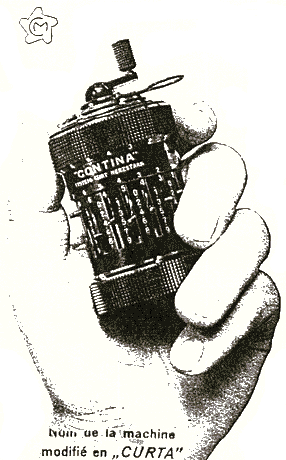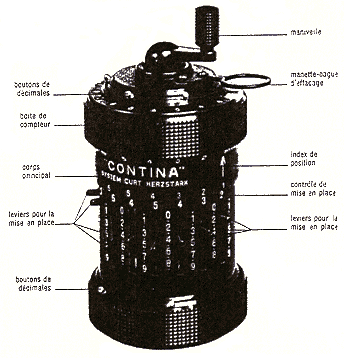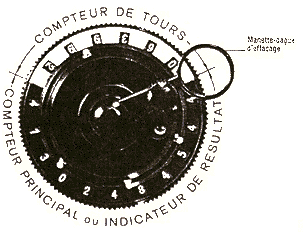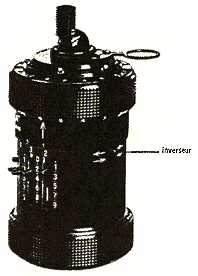 |
CONTINA
| |
| Weight 230 gr. Name of the machine changed to "CURTA". |
 |
CONTINA
| |
| Weight 230 gr. Name of the machine changed to "CURTA". |
| CONTINA S.A. Mauren/Liechtenstein |
Contina S.A. launches a novelty: a universal pocket calculating machine, robust and efficient. It is a high precision device, constructed according to the principles of fine-mechanical mass production and with the experience of several decades provided by the designer C. Herzstark specializing in the construction of calculating machines.
One sees on the cover illustration that the dimensions of this machine are extremely small. One can easily hold it in one hand or put it in one's pocket without any inconvenience. It answers to the long term demand by calculators and fills a niche that has always existed for calculating machines.
The Contina finds its place everywhere where a more or less fixed machine cannot be used, and where one needs fast and reliable results.
It will not fail to become an indispensable aid for traveling
merchants, the building contractor on the construction site
the technician in his workshop, the designer at his drawing
board, the scientist in his lab, and the even student,
i.e., where the use of a noisy machine is intolerable and where it isn't
possible or practical to bring a heavy and cumbersome machine. On the other
hand, one will soon see this machine in commercial or technical
offices, in banks and administrative offices, at
counters, in short, any place where one needs fast access to a
calculating machine.
The most important idea behind this new machine was to create a miniature
high-precision calculating machine, capable of
competing with modern, fixed, universal hand driven machines,
millions of which are spread all over the world,
and with key-driven machines, with visible means of checking numbers
and continuous carrying of tens on both counters.
| Type I: | 8x6x11 digits |
| Type II: | 11x9x14 digits |
| Type IIa: | 12x7x16 digits |
 |
Fig. 1 |
The machine (fig. 1) comprises a main body on which a rotating carriage is mounted which contains the counter mechanisms. The main body contains the setting mechanism, the knobs of which stick out from slits. On the bottom are the white movable knobs for the decimal points. Control digits appear above each slit. The operation is controlled by the crank. The carriage (see fig. 2) contains the mechanism of the revolution counter (set of digits in the white segment) and that of the main counter (also called result register, set of digits in the black segment), movable decimal point indicators as well as the erasing mechanism with the retractable handle.
 |
Fig. 2 |
The numbers (for example the numbers to be added, one of the two factors of the multiplication, or the divisor of the division) are set by means of the sliding knobs that stick out of the slits. To set a number, one pushes the corresponding knob until it is level with the same number in the column. It appears then in the control window.
Control of the number set is simple because all digits remain visible in a horizontal line and aligned with the slits. One avoids therefore the time loss caused by reading the numbers zig-zag along the knobs.
In each revolution, the crank hits an easily perceptible notch, facilitating counting the number of revolutions during the calculation. When pulled or pushed slightly along the axis, the crank moves between two stop positions, the lower one for augmentative calculations (adding, multiplication) and the upper one for diminutive calculations (subtraction, division). In both cases the crank has to be turned clockwise. It is blocked from rotating in the opposite direction.
The revolution counter (digits in the white segment) counts the number of revolutions made by the crank and indicates for addition the number of terms; for multiplication, the multiplier; for division, the quotient; for calculation of a root, the root. The revolution counter is operated in correspondence with the position of the carriage.
The main counter (digits in the black segment) indicates for addition, subtraction and multiplication, the result; for division, depending on the calculation method used, the remainder or the dividend.
The continuous carrying of tens on both counters enables a considerable speed-up for many operations and reduces the number of revolutions of crank (e.g. for the simplified method multiplication). It also enables the addition of multipliers (important for instance for cubatures and the calculation of interests).
Clearing the numbers is done by the handle with a ring (see fig. 1 and 2). It can be moved in two directions. It has two rigid stop positions where the clear segment borders the black one. The handle can be passed over both counters simultaneously or over one of each separately in order to set the numbers to zero.
 |
Fig. 3 The machine viewed from behind |
Sample calculation. The numbers shown in figures 1 and 2 are those of the following multiplication: 645 432 x 63 992. The multiplicand can be seen in the control windows (fig. 1), the multiplier on the revolution counter and the product on the main counter (fig. 2).
The duration of this calculation, including setting the numbers, is about 15 seconds for 29 revolutions. But if the simplified method of multiplication is used, made possible by the continuous carrying of tens, it is sufficient to make only 13 rotations in about 10 seconds.
A division with a 6 digit quotient is possible in 30 seconds on average, including setting the numbers.
All other operations can be done in a minimum amount of time, using methods already known for the large universal machines.
| The Contina protected against damage in its anti-shock case. |  |
Manufacturer:
For sale at:
Reproduction of texts and illustrations, even
partial, is prohibited without our permission and without indication of the
source.
Illustrations and descriptions can be subject
to minor modifications.
16 49 10 f
Andries de Man